
Electrical Raceways, Conduit, Cable Trays, and Electrical Fittings
Raceways, conduit, and cable trays are an essential part of any infrastructure that relies on electricity. This article will discuss types of raceways, conduits,
and cable trays, as well as the different materials used in them and their fittings and connectors.
A raceway, or raceway system, is an enclosed method for protecting electrical wires and cables from corrosion, water, and other physical threats using conduit, tubing, or
other confined structures. Conduit includes tubes and connectors that route wires through a space. Cable trays are an open support and organization system used to hold
cables. Whether you're searching for electrical raceways, metal
conduits, PVC conduits, flexible conduits, liquid tight conduits, cable trays, conduit connectors, or conduit fittings, Elliott Electric Supply has the electrical supplies you need.
What is a Raceway?
Whether a buried/underground raceway used outdoors or a surface raceway used in residential and commercial spaces, electrical raceways completely enclose wires and
cables for protection and organization. Raceways keep your cables safe from corrosion, water, and many other
physical threats. Common types of raceways
include metal (EMT, IMC, RMC, GRC, FMC) conduit, nonmetallic (PVC) conduit, Liquid tight (LFMC) conduit, electrical nonmetallic tubing (ENT), nonmetallic latching
raceways, and surface metallic raceways with removable covers.
Electrical Metal Tubing (EMT) Conduit
Electrical metal tubing (EMT) conduit is a more economical and thinner-walled option made from coated steel or aluminum.
EMT is flexible enough to be cut and bent into necessary shapes. This conduit type doesn't offer the same protection as
rigid metal conduits, but is lighter and can be paired with conduit fittings, eliminating the need for threading.
EMT is best used indoors and away from moisture.
Shop EMT Conduit
Shop EMT Fittings
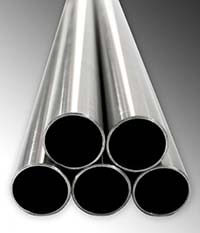
Electrical metal tubing (EMT) conduit is a more economical and thinner-walled option made from coated steel or aluminum.
EMT is flexible enough to be cut and bent into necessary shapes. This conduit type doesn't offer the same protection as
rigid metal conduits, but is lighter and can be paired with conduit fittings, eliminating the need for threading.
EMT is best used indoors and away from moisture.
Shop EMT Conduit
Shop EMT Fittings
Intermediate Metal Conduit (IMC)
Intermediate Metal Conduit (IMC) was specifically designed to protect insulated electrical conductors
and cables from outdoor exposure. IMC is less expensive and features an intermediate pipe wall thickness
(thicker than EMT and thinner than RMC).
Shop IMC Conduit
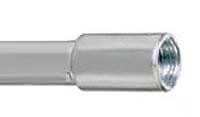
Intermediate Metal Conduit (IMC) was specifically designed to protect insulated electrical conductors
and cables from outdoor exposure. IMC is less expensive and features an intermediate pipe wall thickness
(thicker than EMT and thinner than RMC).
Shop IMC Conduit
Rigid Metal Conduit (RMC) or Galvanized Rigid Conduit (GRC)
Rigid Metal Conduit (RMC) is made of aluminum or steel and is often used outdoors to protect from physical damage.
Shop Rigid Conduit Fittings
A galvanized rigid metal conduit uses galvanized steel for its construction and is one of the sturdiest types of electrical conduit.
Shop Galvanized Rigid Metal Conduit
An aluminum conduit, like a galvanized steel conduit,
come in tubes and is generally used in commercial and industrial applications where corrosion resistance is a minimal factor.
Shop Aluminum Conduit
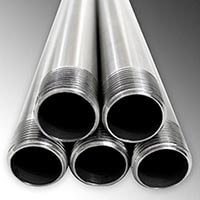
Rigid Metal Conduit (RMC) is made of aluminum or steel and is often used outdoors to protect from physical damage.
Shop Rigid Conduit Fittings
A galvanized rigid metal conduit uses galvanized steel for its construction and is one of the sturdiest types of electrical conduit.
Shop Galvanized Rigid Metal Conduit
An aluminum conduit, like a galvanized steel conduit,
come in tubes and are generally used in commercial and industrial applications where corrosion resistance is a minimal factor.
Shop Aluminum Conduit
PVC Coated Rigid Metal Conduit
Flexible Metal Conduit (FMC)
Flexible metal conduit (FMC) features a spiral construction that enable it to pass through walls and other
structures. FMC protects electrical wiring in commercial and industrial buildings.
Shop FMC Conduit
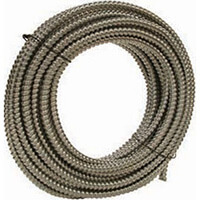
Flexible metal conduit (FMC) features a spiral construction that enable it to pass through walls and other
structures. FMC protects electrical wiring in commercial and industrial buildings.
Shop FMC Conduit
Rigid PVC Conduit
Rigid PVC Conduit is a nonmetallic conduit that can be installed underground, exposed, or encased. PVC conduit is versatile,
easy to install, affordable, and lightweight. Rigid PVC conduit has two common types: Schedule 80 and Schedule 40.
Shop Rigid PVC Conduit
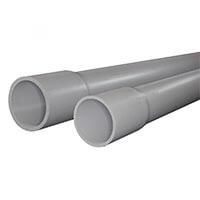
Rigid PVC Conduit is a nonmetallic conduit that can be installed underground, exposed, or encased. PVC conduit is versatile,
easy to install, affordable, and lightweight. Rigid PVC conduit has two common types: Schedule 80 and Schedule 40.
Shop Rigid PVC Conduit
What's the difference between Schedule 80 and Schedule 40 PVC conduit?
While both a Schedule 80 and a Schedule 40 are made of rigid PVC, Schedule 80 has greater weight,
thicker pipe walls, and a smaller inside diameter, compared to Schedule 40 PVC. For harsh environments or environments with a risk of
physical damage, Schedule 80 PVC conduit may be required. Schedule 40 PVC is typically less expensive and can be filled with more wires within the conduit
due to its larger inside diameter. See the NEC® for conduit requirements.
Shop PVC Schedule 40 Conduit
Shop PVC Schedule 80 Conduit
PVC Conduit Fittings and Accessories
PVC Fittings and Adapters
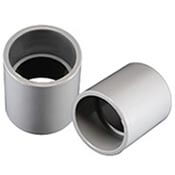
Conduit fittings secure materials to each other or to an electrical device. These ensure electrical flow remains uninterrupted. Adapters are a
type of conduit fitting that connect two conduit thread sizes, male and female conduits, or even conduits made from different materials.
Shop PVC Fittings and Adapters
Condulet Bodies
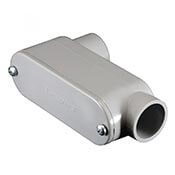
Condulet bodies are a specific conduit shape that have a cover opening for ease-of-access to electrical wires. Additionally,
with their compact size, condulet bodies boast of simple installation which can save on inventory and labor costs.
Shop PVC Condulet Bodies
Caps and Plugs
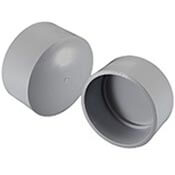
Conduit caps and plugs are metal or plastic barriers that protect internal wiring from weather and environmental factors by sealing conduit ends (caps) or holes (plugs).
Shop PVC Caps and Plugs
PVC Elbows
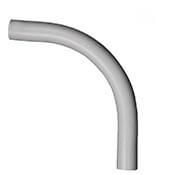
Elbows behave similarly to couplings, except they allow conduits to curve as opposed to remaining straight. Schedule 40 elbows have a larger inside diameter
and thus are easier to pull wires through at an angle compared to Schedule 80 elbows.
Shop PVC Elbows
PVC Clamps and Straps
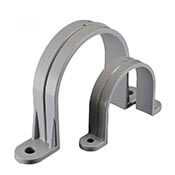
Clamps and straps support conduits and secure them to a surface. Depending on what's needed to mount your conduit to a surface, a combination of these
supports may be required.
Shop PVC Clamps and Straps
Spacer
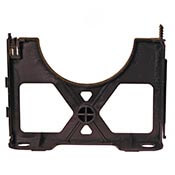
Electrical spacers are thin strips of metal or plastic that can be used to stabilize raceways. Spacers can also provide protection to outlet faceplates, or
support loose outlets and plugs.
Shop PVC Spacers
Liquidtight Conduit
Liquid Tight Flexible Metal Conduit (LFMC)
Liquid tight flexible metal conduit (LFMC) is FMC Conduit with an added plastic coating for moisture resistance.
LFMC is different from LFNC in that is has a steel metal layer under the plastic coating, making it suitable in
locations where protection from physical damage is necessary. Because Liquidtight LFMC is moisture resistant, flexible,
and resists kinking, it's often used to protect electrical equipment connections (like air conditioners) in outdoor locations.
Shop LFMC Conduit
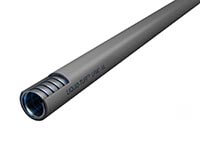
Liquid tight flexible metal conduit (LFMC) is FMC Conduit with an added plastic coating for moisture resistance.
LFMC is different from LFNC in that is has a steel metal layer under the plastic coating, making it suitable in
locations where protection from physical damage is necessary. Because Liquidtight LFMC is moisture resistant, flexible,
and resists kinking, it's often used to protect electrical equipment connections (like air conditioners) in outdoor locations.
Shop LFMC Conduit
Liquid Tight Flexible Nonmetallic Conduit (LFNC‑A, LFNC‑B, and LFNC‑C)
Liquid tight flexible nonmetallic conduit (LFNC) has a plastic coating. When LFNC is used with sealed fittings,
they become watertight. LFNC is suitable for wet or damp locations and some hazardous locations.
LFNC is often used to protect wires for outdoor lighting or pools.
Shop LFNC Conduit
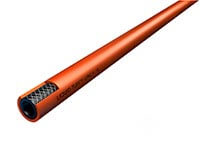
Liquid tight flexible nonmetallic conduit (LFNC) has a plastic coating. When LFNC is used with sealed fittings,
they become watertight. LFNC is suitable for wet or damp locations and some hazardous locations.
LFNC is often used to protect wires for outdoor lighting or pools.
Shop LFNC Conduit
An electrical nonmetallic tubing (ENT) is a light, flexible, corrugated, nonmetal raceway often used to protect wires
within walls, floors, and some ceilings types. ENT should not be used outdoors where it would be exposed to the
sun's UV light, but it can be encased in concrete with code-compliant PVC fittings.
Shop ENT Raceways and Fittings
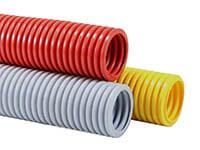
An electrical nonmetallic tubing (ENT) is a light, flexible, corrugated, nonmetal raceway often used to protect wires
within walls, floors, and some ceilings types. ENT should not be used outdoors where it would be exposed to the
sun's UV light, but it can be encased in concrete with code-compliant PVC fittings.
Shop ENT Raceways and Fittings
Nonmetallic Raceways are lightweight and cost effect raceway. Nonmetallic raceways are used for exposed work,
where the electrical conduit is subject to corrosive and wet environments.
Shop Nonmetallic Raceways
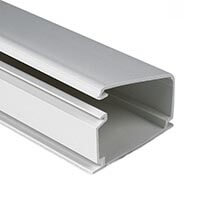
Nonmetallic Raceways are lightweight and cost effect raceway. Nonmetallic raceways are used for exposed work,
where the electrical conduit is subject to corrosive and wet environments.
Shop Nonmetallic Raceways
Metallic Raceways are a durable raceway that can be bent and curved into a desired shape.
These will minimize the risk of electromagnetic interference.
Shop Metallic Raceways
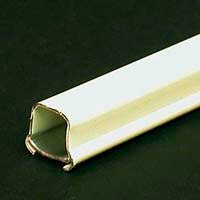
Metallic Raceways are a durable raceway that can be bent and curved into a desired shape.
These will minimize the risk of electromagnetic interference.
Shop Metallic Raceways
A Cable Tray is a support system used to organize electrical wires. While cable trays can be covered
to protect wires from dust and falling debris, they do not completely enclose the wire.
Cable trays are often made of steel, aluminum, or plastic.
Shop Cable Trays
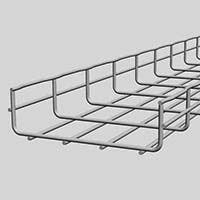
A Cable Tray is a support system used to organize electrical wires. While cable trays can be covered
to protect wires from dust and falling debris, they do not completely enclose the wire.
Cable trays are often made of steel, aluminum, or plastic.
Shop Cable Trays
Electrical Fittings and Connectors
Pipe coupling and PVC connectors are useful when forming the custom shapes required by building specifications.
There are many forms of electrical conduit fittings, the most common of which are listed below. Because conduit
fittings vary in size depending on the diameter of the raceway, fittings ought to be selected based on the type of
thread used in and the diameter of the raceway. All wiring in a building must meet proper
safety codes.
Connector Fittings
Connector fittings join components of an electrical system. You must ensure compatibility
between connectors and tread. The most common uses for connector fittings are:
Shop Connector Fittings
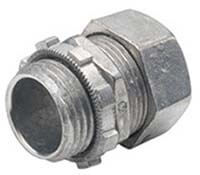
Connector fittings join components of an electrical system. You must ensure compatibility
between connectors and tread. The most common uses for connector fittings are:
Shop Connector Fittings
Elbow
Elbow conduit fittings are bent at 45 and 90 degrees. Elbow fittings connect materials of the same type together.
Shop Elbow Fittings
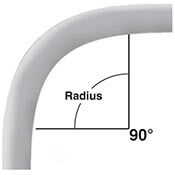
Elbow conduit fittings are bent at 45 and 90 degrees. Elbow fittings connect materials of the same type together.
Shop Elbow Fittings
Pipe Clamp
A pipe clamp is made from metal or plastic. Pipe clamps connect pipe (conduit) to a wall, ceiling, or pipe hangar assembly.
Recommended for hanging cold pipe lines, pipe clamps may or may not be insulated and are great
for securing conduit, PVC pipes, cables, etc.
Shop Pipe Clamps
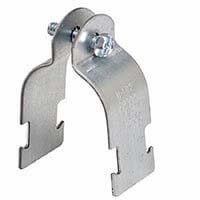
A pipe clamp is made from metal or plastic. Pipe clamps connect pipe (conduit) to a wall, ceiling, or pipe hangar assembly.
Recommended for hanging cold pipe lines, pipe clamps may or may not be insulated and are great
for securing conduit, PVC pipes, cables, etc.
Shop Pipe Clamps
Strap
A conduit strap secures the conduit to a surface. This helps reduce the risk of breakage.
Shop Conduit Straps
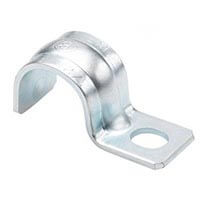
A conduit strap secures the conduit to a surface. This helps reduce the risk of breakage.
Shop Elbow Fittings
Pipe Coupling
Pipe coupling fittings join like with like in a straight line of conduit. These look like a small tube
open on both ends with the purpose of securing two materials together. Typically they join two tubes with the same thread types, as
their sockets are the same size on both ends; however, pipe coupling may connect conduits of differing sizes.
Shop All Pipe Coupling
There are three types of coupling fittings:
Metallic Coupling
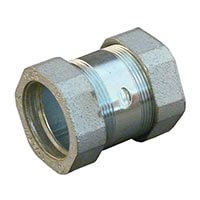
Metallic couplings are used only for metallic conduits and are typically secured with screws.
Shop Metallic Coupling
Nonmetallic Coupling
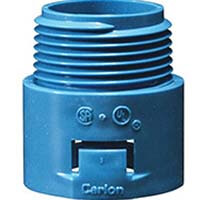
Nonmetallic Couplings are used for a nonmetallic conduit and typically attached with solvent cement.
Shop Nonmetallic Couplings
Speciality Fittings
There are many specialty conduit fittings. The most common include:
Weatherheads
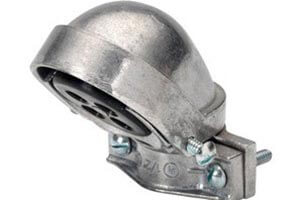
Weatherheads are a weather-resistant cap installed outside the home to provide access for maintenance and repairs.
Shop Weatherhead Fittings
Reducer Couplings
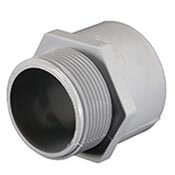
Reducer couplings are used on couplings that have threaded ends.
Shop Reducer Couplings
Offset Couplings
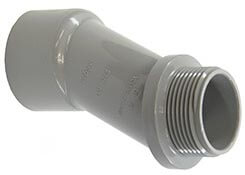
Offset couplings are suited for devices that may be pushed or pulled. These ensure energy flow remains stable.
Shop Offset Couplings
Weatherheads

Weatherheads are a weather-resistant cap installed outside the home to provide access for maintenance and repairs.
Shop Weatherhead Fittings
Offset Couplings

Offset couplings are suited for devices that may be pushed or pulled. These ensure energy flow remains stable.
Shop Reducer Couplings
Electrical Fitting and Connector Accessories
According to building electrical codes, some conduits require particular accessories
to accompany their fittings and connectors.
Conduit Locknuts
Conduit locknuts secure threaded connectors to a steel electrical outlet or metal electrical box.
Shop Conduit Locknuts
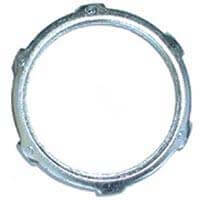
Conduit locknuts secure threaded connectors to a steel electrical outlet or metal electrical box.
Shop Conduit Locknuts
Bushing
Snap-in bushing, insulating bushing, and plastic bushing are
knockout hollow insulators that allow conductive material to
pass through a grounded conducting barrier, often used for safety with 4 AWG wires.
Snap-In Bushing
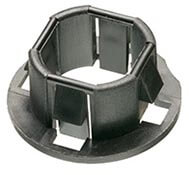
Snap-in bushings do as their names suggest—they snap into place as insulators to protect wires, cables, and tubing from possible abrasions.
Shop Snap-In Bushing
Insulating Bushing
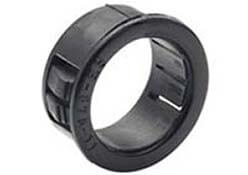
Insulating bushings are used where nonmetallic low voltage cabling is installed to protect from sharp edges.
Shop Insulating Bushing
Plastic Bushing
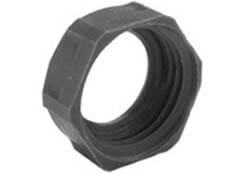
Plastic bushings can be used with any material, are resistant to corrosion, and do not transfer heat. This means plastic bushings involve less
maintenance than metallic counterparts.
Shop Plastic Bushing

Snap-In Bushing
Snap-in bushings do as their names suggest—they snap into place as insulators to protect wires, cables, and tubing from possible abrasions.
Shop Snap-In Bushing

Insulating Bushing
Insulating bushings are used where nonmetallic low voltage cabling is installed to protect from sharp edges.
Shop Insulating Bushing

Plastic Bushing
Plastic bushings can be used with any material, are resistant to corrosion, and do not transfer heat. This means plastic bushings involve less
maintenance than metallic counterparts.
Shop Plastic Bushing
Materials Used for Raceways, Conduits, and Conduit Fittings
Different types of materials are used to make electrical conduit, raceways, and conduit fittings, including:
Stainless Steel

Judged by thickness and stiffness, a steel conduit is used when mechanical protection, wiring regulations,
and environmental factors impact installation.
Shop Stainless Steel
Aluminum

An aluminum conduit, like a galvanized steel conduit, comes in tubes and is generally used in commercial
and industrial applications where corrosion resistance is a minimal factor.
Shop Aluminum
PVC (Polyvinyl Chloride Conduit)

PVC conduit is the lightest, cheapest, and most versatile type, typically sealed with metal
or plastic fittings and sealed with solvent-welded connections.
Shop PVC
Stainless Steel

Judged by thickness and stiffness, a steel conduit is used when mechanical protection, wiring regulations,
and environmental factors impact installation.
Shop Stainless Steel
Aluminum

An aluminum conduit, like a galvanized steel conduit, comes in tubes and is generally used in commercial
and industrial applications where corrosion resistance is a minimal factor.
Shop Aluminum
PVC (Polyvinyl Chloride Conduit)

PVC conduit is the lightest, cheapest, and most versatile type, typically sealed with metal
or plastic fittings and sealed with solvent-welded connections.
Shop PVC
Other Helpful Conduit and Raceway Guides:
Learn More About Our Other Products:
Warning: When using this information to perform electrical work, call a licensed electrician or consult the NEC® for safety. All
licensed electricians have passed examinations covering the National Electric Code®, know state and local building codes, and may carry insurance to cover damages.